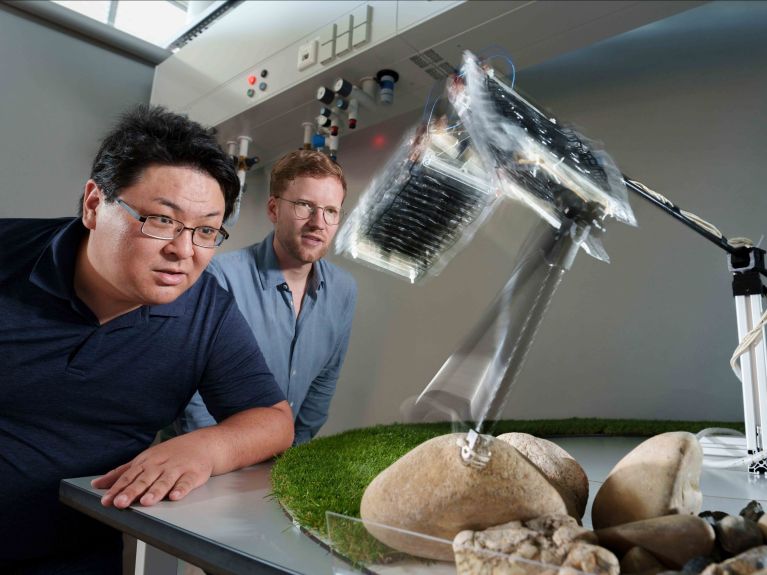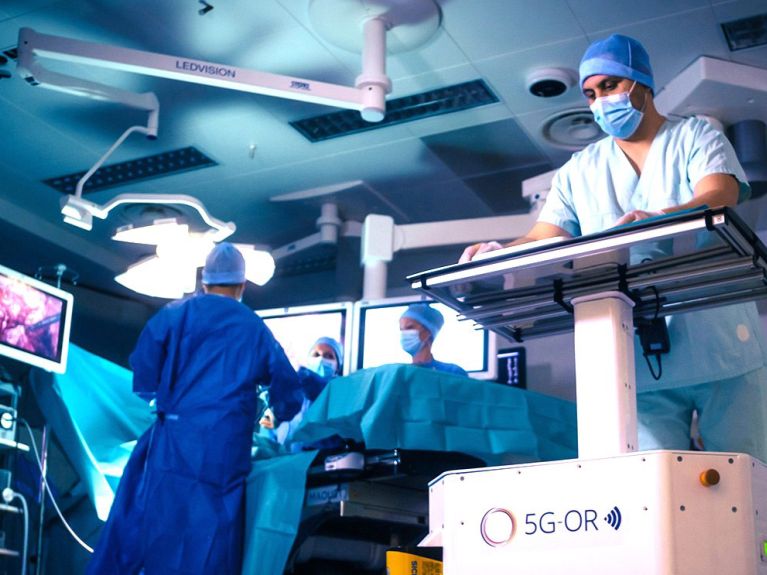Research without borders – with real-world impact
From AI to biotechnology: closely connected to the business world, Germany’s non-university research institutions are setting global standards.

Toshihiko Fukushima and Thomas Buchner watch intently as the robotic leg they developed jumps in a circle, successfully navigating uneven surfaces such as grass, sand and stones. No bulky electric motor, no jerky movements, no complex sensors – everything typically associated with robots is different with this robotic leg. This is because it operates energy-efficiently using electrohydraulic – i.e. artificial – muscles, and draws its inspiration in terms of mobility from humans and animals. This innovation was developed through a research partnership between the Max Planck Institute for Intelligent Systems in Stuttgart and ETH Zurich.
Max Planck Society: 4,500 collaborative projects
The project is an example of the intense international cooperation pursued by the Max Planck Society, Founded in 1948 in Göttingen in 1948, the society currently runs more than 4,500 collaborative projects with around 5,400 partners in over 100 countries. Its 84 institutes and facilities make the Max Planck Society one of the world’s leading centres for basic research in the natural sciences, life sciences, humanities and social sciences outside the university sector. A total of 31 Nobel Prize winners have come from the Max Planck Society, clearly placing it among the world’s foremost research institutions.
Working with their team leaders Robert Katzschmann and Christoph Keplinger, Fukushima and Buchner also have ambitious goals in Stuttgart and Zurich. Although the robotic leg is currently still mounted on a pole and cannot move freely, further research will focus on developing a walking robot with artificial muscles. If successful, the potential practical applications are significant: “If we combine the technology of the robotic leg with a four-legged or humanoid two-legged robot, we could one day – once it’s battery-powered – use it as a rescue robot,” says Katzschmann.
Helmholtz Association: cooperation with industry partners
Researchers at Germany's largest non-university research organisation, the Helmholtz Association, are also looking for answers to the pressing questions of our time. More than 46,000 employees at 18 research centres focus on areas including energy, earth and environment, health, information, aeronautics, materials, space and transport. Knowledge and technology transfer is one of the cornerstones of the Helmholtz mission.
How this transfer can work in practice is demonstrated by the Helmholtz Association’s research university – the Karlsruhe Institute of Technology(KIT). Celebrating its 200th anniversary this year, KIT advances research in three key areas, for example in collaboration with the IT company IBM: digital innovations for services and platforms, artificial intelligence (AI), and human–machine collaboration. Among other things, the team is investigating the extent to which automated solutions can take over routine tasks in the future. Dr Carsten Holtmann, responsible at IBM for AI innovation and collaboration with KIT, emphasises: “Collaborative innovation is the order of the day – with a view to strengthening our position, contributing directly to key technologies such as generative AI, and driving applied research forward.”

Fraunhofer Society: focus on knowledge and technology transfer
One project being run by the Fraunhofer Society is also looking at AI applications, but in the healthcare sector. Founded in 1949, the organisation currently operates 76 institutes and research facilities in Germany with a total of almost 32,000 employees. The international focus of the Fraunhofer Society is reflected not only in its eight foreign branches in Europe, North and South America, and Asia, but also in its specific projects. In connection with the project “5G-OR”, a Franco-German team is developing highly advanced hybrid operating rooms that enable new applications based on 5G connectivity and AI. The project involves collaboration between engineers, entrepreneurs, surgeons and anaesthetists from Mannheim, Berlin and Strasbourg.
“5G technology enables secure, flexible and reliable wireless communication – a data highway for exchanging information,” explains Johannes Horsch, project lead for health technologies at the Fraunhofer Institute for Manufacturing Engineering and Automation IPA. Horsch is positive about the close Franco-German cooperation in the project: “It promotes cross-border data exchange, helping us advance surgical practice and improve patient safety in Europe.”
The next step is the transfer of the technology to clinical practice – this includes testing, medical approval and market access via industrial partners and start-ups.
Leibniz Association: new therapies for cancer
Scientists at the Leibniz Institute of Plant Biochemistry (IPB) in Halle an der Saale are aiming to develop new cancer drugs using natural substances and AI. The IPB belongs to the Leibniz Association, an organisation that is made up of 96 independent research institutions across Germany. Their focus ranges from the natural, engineering and environmental sciences to economics, spatial and social sciences and the humanities.
Leibniz institutions work closely with universities, industry and other partners at home and abroad – including in a current project involving the IPB, Martin Luther University Halle-Wittenberg and the private Dhofar University in Oman. The focus of the research is on plants, fungi and microbes that are considered promising candidates for new cancer treatments. Studying their effects is complex and costly, however. This is where AI can help: using modern cell content analytics and AI-based evaluation, researchers have succeeded in more accurately predicting the effects of cytotoxic natural substances, thereby accelerating the development of new cancer drugs. The method can also help understand how existing chemotherapeutics work and identify interactions with other medications.


